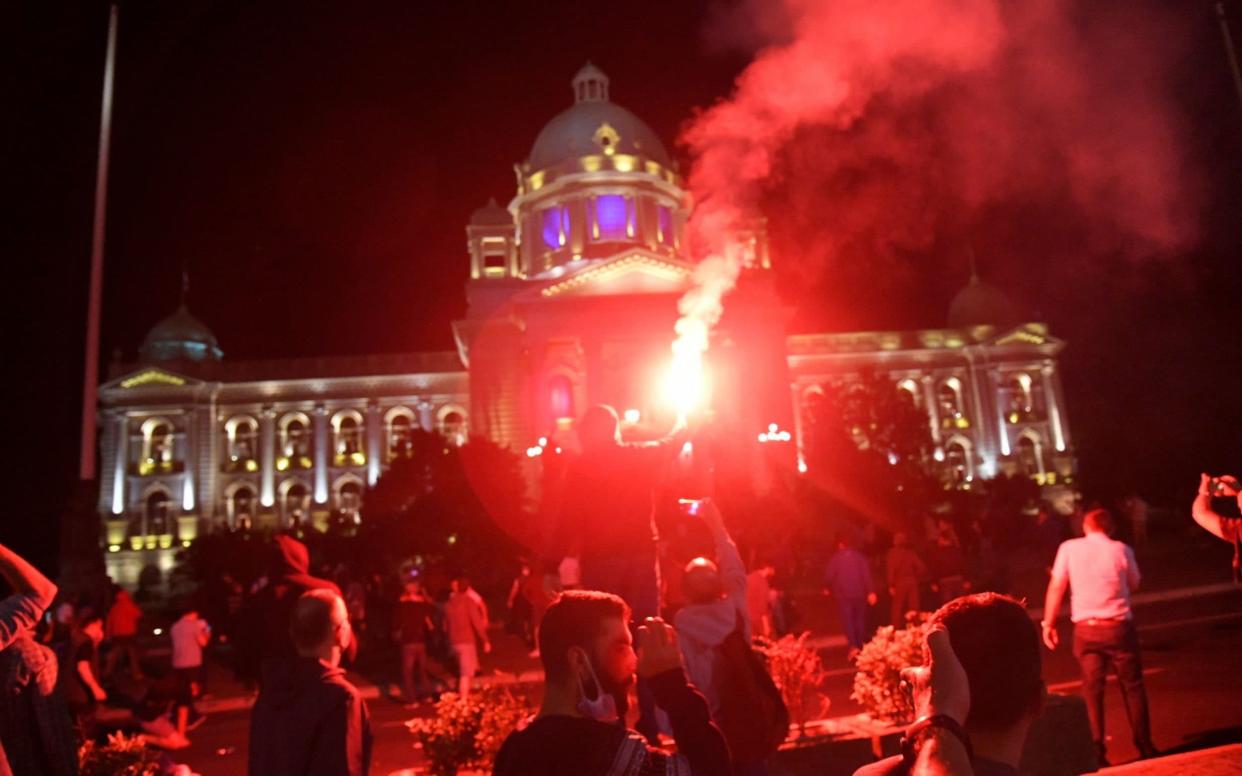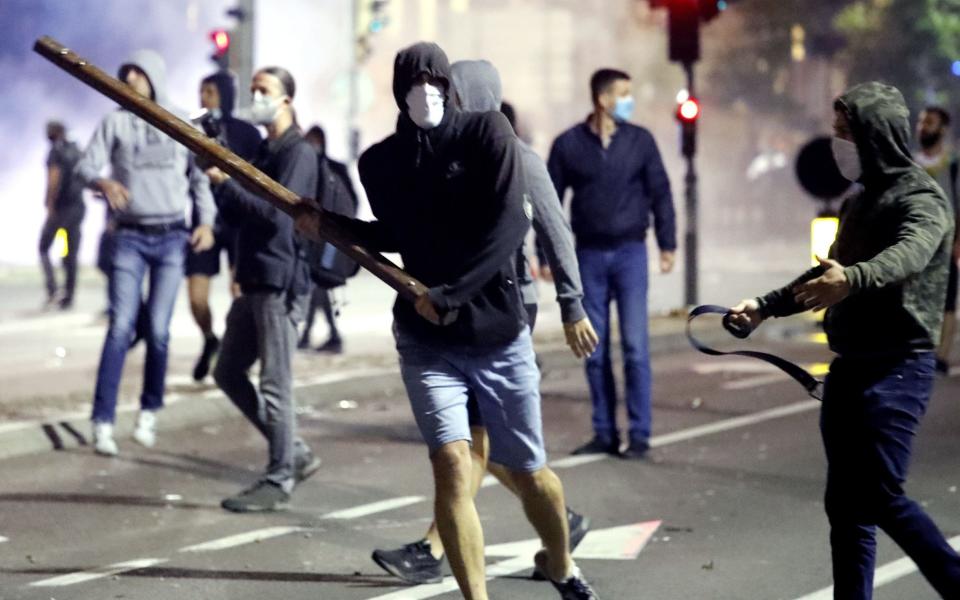Serbia's President backs down on plan for second lockdown to counter virus after violent protests

Serbia’s populist president is backing down on plans to reinstate a coronavirus lockdown in the capital Belgrade this weekend after thousands protested against the move, sparking violent clashes with police.
Thousands fought running battles and attempted to storm the parliament on Tuesday after Aleksander Vucic announced the curfew. That followed health officials reporting the highest single-day death toll of 13 amid 299 new Covid-19 cases.
More than 40 police officers were hurt in the clashes, which lasted for six hours. Protesters demanding Vucic’s resignation hurled flares, stones, bottles and eggs at them. They set several police vehicles on fire.
Police fired tear gas at the protesters, with far-right nationalists blamed for stirring up the unrest. They broke open a door to the parliament before being repelled.
At least 23 protesters were arrested, and 17 injured. Scenes of police brutality were captured on TV. In one incident, officers used batons to beat three men sitting peacefully on a bench.
Opponents blame the autocratic Serbian leader for the spike in cases. Vucic lifted lockdown in May, paving the way for him to cement his grip on power in parliamentary elections on June 21. Football and tennis matches were also played in packed stands.
Mr Vucic said yesterday a final decision would be taken tomorrow. He suggested he was listening to his crisis team, who were opposed. He said: "It would be shameful for me to go back on my words under pressure from hooligans, but I think we are showing our strength by showing that I do not decide alone”
The initial proposal for lockdown was for a Friday night to Monday morning curfew. A ban on gatherings of more than five people was also announced.
The overall infection figures in Serbia remain low, with 341 deaths recorded since the start of the crisis. More than 44,300 have died in the UK.
But there are fears of rising rates across the Balkans and eastern Europe after successful hardline lockdowns, and Mr Vucic’s backdown will not help Serbia fight a renewed surge with hospitals struggling to cope. Bosnia, Kosovo and North Macedonia are all seeing spikes.
Romania and Bulgaria today both confirmed their highest number of Covid-19 infections since the outbreak began. Bulgaria, hit by 254 deaths throughout the crisis, recorded 188 infections. Romania, where the total death toll is 1817, had 555 new cases.
Romania’s Constitutional Court ruled two weeks ago that the government no longer has the power to enforce quarantine, isolation or hospitalisation measures, declaring them a ‘deprivation of liberty’.
The ruling reportedly led to hundreds of infected patients leaving hospitals of their own volition. Rares Bogdan, an MEP for the European People's Party group, said the ruling “undermines the Romanian state.”
Bogdan Tanase, head of Romania’s Doctors’ Alliance told The Daily Telegraph: “The ruling was a bad decision: bad timing to be precise. It could bring a resurgence in the number of cases.”
James Ker-Lindsay, visiting professor at the LSE, and an expert in south-east Europe, said the rise in the region was a legacy of authorianism, and the reaction when lockdown was lifted.
"The lockdown was very tough and people went with it. But it's hard to do it again. And it's a very sociable culture, the nightclubs are open, and governments have been saying it's all OK, all of which is fuelling the surge"
Austria has issued travel warnings for Bulgaria, Romania and Moldova. Arrivals from those countries have to provide proof of a negative test result or go into two weeks’ quarantine.
The Netherlands shut its borders to people from Serbia and Montenegro today, a week after opening them.

Police fired several rounds of tear gas at the protesters, with far-right nationalists blamed for stirring up the unrest. They pushed through a cordon and broke open a door to the parliament before being repelled. At least 23 protesters were arrested, and 17 injured.
Opponents blame the autocratic Serbian leader for the spike in cases. Vucic controversially lifted lockdown in May, paving the way for him to cement his grip on power in parliamentary elections on June 21. Football and tennis matches were also played in packed stands despite warnings the country faced a second wave of infection without social distancing.
Mr Vucic abandoned the proposed lockdown plan yesterday, citing the need instead to kick-start the economy. He also pleaded for an end to further planned protests, saying they could fuel spread of the disease.
The proposal for lockdown was for a Friday night to Monday morning curfew. A ban on gatherings of more than five people was also announced.

The overall infection figures in Serbia remain low, with 341 deaths recorded since the start of the crisis. More than 44,300 have died in the UK.
But there are fears of rising rates across the Balkans and eastern Europe after successful hardline lockdowns, and Mr Vucic’s backdown will not help Serbia fight a renewed surge with hospitals struggling to cope. Bosnia, Kosovo and North Macedonia are all seeing spikes.
Romania and Bulgaria yesterday (Wed) both confirmed their highest number of Covid-19 infections since the outbreak began. Bulgaria, hit by 254 deaths throughout the crisis, recorded 188 infections. Romania, where the total death toll is 1817, had 555 new cases.
Romania’s Constitutional Court ruled two weeks ago that the government no longer has power to enforce quarantine, isolation or hospitalisation measures, declaring them a ‘deprivation of liberty’. That makes another lockdown impossible.
The ruling also reportedly led to hundreds of infected patients leaving hospitals of their own volition, which would help explain the rise. Rares Bogdan, an MEP for the European People's Party group, said the ruling “undermines the Romanian state.”
Bogdan Tanase, head of Romania’s Doctors’ Alliance told The Daily Telegraph: “The court ruling was a bad decision: bad timing to be precise. It could bring a resurgence in the number of cases.”
Austria has now issued travel warnings for Bulgaria, Romania and Moldova. Arrivals from those countries now have to provide proof of a negative test result or go into two weeks’ quarantine.
The Netherlands shut its borders to people from Serbia and Montenegro yesterday (Wed), a week after opening them. It advised Dutch travellers to stay away from the counties.


